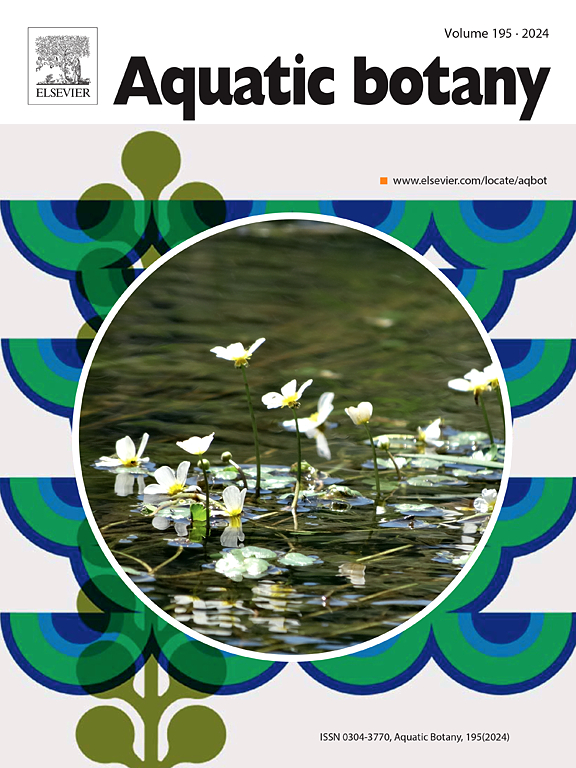芦苇生长、形态和氮吸收适应性对氮形态和氧有效性的响应
IF 2.6
4区 生物学
Q2 MARINE & FRESHWATER BIOLOGY
引用次数: 0
摘要
研究了芦苇对不同氮素形态和氧供应的响应。选取14日龄植株,随机分配到平衡浓度(500 µM n)下3种n形态(NH4+、NO3-、NH4NO3)和2种O2条件(常氧和低氧)下6种处理(n = 10)。所有植株在温室条件下栽培77天。在常氧条件下,NH4+饲喂植物的干量产量和NH4+去除率显著高于NO3饲喂植物。此外,饲喂NH4+-和nh4no3的植株根系干质量和氮素利用效率(NUE)显著高于饲喂NO3——的植株。这表明常氧条件下对NH4+的偏好。在低氧条件下,植物的生长、生物量、氮去除能力和氮素利用效率均下降。植株还通过减少根干质量、根长和根径来调节根系性状。在低氧条件下,不同氮形态的植株干质量无显著差异。缺氧条件下,NH4+处理植株的茎根比增加,NO3处理植株的茎根比保持不变。此外,NO3—供试植物的根系大小、生物量、NH4+去除率和氮肥利用率变化较小,表明其在缺氧条件下的稳定性优于NH4+供试植物。不同形态氮素的响应模式不同,可能与根系对氮素吸收和同化的能量保存有关。karka似乎同时利用NH4+和NO3-,但当O2充足时,它更倾向于使用NH4+。此外,该物种可以忍受长时间的缺氧,适应模式似乎依赖于n形式。本文章由计算机程序翻译,如有差异,请以英文原文为准。
Growth, morphology, and nitrogen uptake adaptivity of Phragmites karka in response to nitrogen forms and oxygen availability
The responses of Phragmites karka to different N-forms and O2 supply were investigated. Fourteen-day old plants were selected and assigned randomly to six experimental treatments (n = 10), with three N-forms (NH4+, NO3-, NH4NO3) at equilibrium concentration (500 µM N) and two O2 conditions (normoxia and hypoxia). All plants were cultivated in greenhouse conditions for 77 days. Under normoxia, NH4+-fed plants had significantly higher dry mass production and NH4+ removal capacity than NO3--fed plants. In addition, the NH4+- and NH4NO3-fed plants had significantly higher root dry mass and nitrogen use efficiency (NUE) compared to the NO3--fed plants. This suggests NH4+ preference under normoxia. Under hypoxia, the plants had reduced growth, biomass production, N removal capacity, and NUE. The plants also modulated root traits by reducing root dry mass, root length and root diameter. The plants had no significant difference in dry mass across N-forms under hypoxia. However, the NH4+-fed plants increased their shoot:root ratios, while the NO3--fed plants retained their shoot:root ratios under hypoxia. Moreover, the NO3--fed plants had slighter changes in root size and biomass, NH4+ removal capacity, and NUE, suggesting better stability under hypoxia compared to the NH4+-fed plants. The different response patterns between N-form are probably due to the energy preservation of roots associated with N uptake and assimilation. It appears that, P. karka utilizes both NH4+ and NO3-, but that it prefer NH4+ when sufficient O2 is available. In addition, this species can tolerate prolonged hypoxia and adaptation patterns appear to be N-form dependent.
求助全文
通过发布文献求助,成功后即可免费获取论文全文。
去求助
来源期刊

Aquatic Botany
生物-海洋与淡水生物学
CiteScore
3.80
自引率
5.60%
发文量
70
审稿时长
6 months
期刊介绍:
Aquatic Botany offers a platform for papers relevant to a broad international readership on fundamental and applied aspects of marine and freshwater macroscopic plants in a context of ecology or environmental biology. This includes molecular, biochemical and physiological aspects of macroscopic aquatic plants as well as the classification, structure, function, dynamics and ecological interactions in plant-dominated aquatic communities and ecosystems. It is an outlet for papers dealing with research on the consequences of disturbance and stressors (e.g. environmental fluctuations and climate change, pollution, grazing and pathogens), use and management of aquatic plants (plant production and decomposition, commercial harvest, plant control) and the conservation of aquatic plant communities (breeding, transplantation and restoration). Specialized publications on certain rare taxa or papers on aquatic macroscopic plants from under-represented regions in the world can also find their place, subject to editor evaluation. Studies on fungi or microalgae will remain outside the scope of Aquatic Botany.
 求助内容:
求助内容: 应助结果提醒方式:
应助结果提醒方式:


